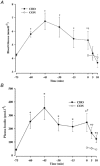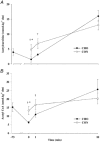Carbohydrate ingestion reduces skeletal muscle acetylcarnitine availability but has no effect on substrate phosphorylation at the onset of exercise in man
- PMID: 12411537
- PMCID: PMC2290622
- DOI: 10.1113/jphysiol.2002.026757
Carbohydrate ingestion reduces skeletal muscle acetylcarnitine availability but has no effect on substrate phosphorylation at the onset of exercise in man
Abstract
This study investigated the effect of reduced acetylcarnitine availability on oxidative metabolism during the transition from rest to steady-state exercise. Eight male subjects completed two randomised exercise trials at 68 % of the peak rate of O(2) uptake (V((O(2)),peak)). On one occasion subjects ingested 1 g (kg body mass)(-1) glucose 75 min prior to exercise (CHO), whereas the other trial acted as a control (CON). Muscle samples were obtained pre- and 75 min post-ingestion, and following 1 and 10 min of exercise. Plasma glucose and insulin were elevated (P < 0.05), and plasma free fatty acids (FFA) were lower at the onset of exercise in CHO. Acetylcarnitine (CON, 4.8 +/- 1.8; CHO, 1.5 +/- 0.9 mmol (kg dry mass (d.m.))(-1), P < 0.05) and acetyl CoA (CON, 13.2 +/- 2.3; CHO, 6.3 +/- 0.6 micromol (kg d.m.)(-1), P < 0.05) were lower at rest, whereas pyruvate dehydrogenase activation (PDHa) was greater in CHO compared with CON (CON, 0.78 +/- 0.07; CHO, 1.44 +/- 0.19 mmol min(-1) (kg wet mass (w.m.))(-1)). Respiratory exchange ratio (RER) was significantly elevated during exercise in CHO. The acetyl groups increased at similar rates at the onset of exercise (1 min) and there was no difference in substrate phosphorylation as determined from lactate accumulation and phosphocreatine degradation between trials. Subsequently, oxidative metabolism during the transition from rest to steady-state exercise was not affected by prior carbohydrate ingestion. Although exercise resulted in the rapid activation of PDH in both trials, PDHa was greater at 1 min in CHO (CON, 2.36 +/- 0.22; CHO, 2.91 +/- 0.18 mmol min(-1) (kg w.m.)(-1)). No differences in muscle metabolite levels and PDHa were observed after 10 min of moderate exercise between trials. In summary, at rest, carbohydrate ingestion induced multiple metabolic changes which included decreased acetylcarnitine availability and small increases in PDHa. The prior changes in PDHa and acetylcarnitine availability had no effect on substrate phosphorylation and oxidative metabolism at the onset of exercise. These data suggest that acetylcarnitine availability is unlikely to be the site of metabolic inertia during the transition from rest to steady-state moderate intensity exercise.
Figures



Similar articles
-
Carbohydrate ingestion prior to exercise augments the exercise-induced activation of the pyruvate dehydrogenase complex in human skeletal muscle.Exp Physiol. 2000 Sep;85(5):581-6. Exp Physiol. 2000. PMID: 11038410 Clinical Trial.
-
Effects of acetate infusion and hyperoxia on muscle substrate phosphorylation after onset of moderate exercise.Am J Physiol Endocrinol Metab. 2001 Dec;281(6):E1144-50. doi: 10.1152/ajpendo.2001.281.6.E1144. Am J Physiol Endocrinol Metab. 2001. PMID: 11701427 Clinical Trial.
-
Pyruvate overrides inhibition of PDH during exercise after a low-carbohydrate diet.Am J Physiol Endocrinol Metab. 2000 Aug;279(2):E275-83. doi: 10.1152/ajpendo.2000.279.2.E275. Am J Physiol Endocrinol Metab. 2000. PMID: 10913026 Clinical Trial.
-
Intramuscular triacylglycerol, glycogen and acetyl group metabolism during 4 h of moderate exercise in man.J Physiol. 2002 Jun 15;541(Pt 3):969-78. doi: 10.1113/jphysiol.2002.018820. J Physiol. 2002. PMID: 12068055 Free PMC article. Clinical Trial.
-
Fuel selection, muscle fibre.Proc Nutr Soc. 1995 Mar;54(1):107-21. doi: 10.1079/pns19950041. Proc Nutr Soc. 1995. PMID: 7568245 Review.
Cited by
-
Acetyl group availability influences phosphocreatine degradation even during intense muscle contraction.J Physiol. 2004 Dec 15;561(Pt 3):851-9. doi: 10.1113/jphysiol.2004.069419. Epub 2004 Oct 21. J Physiol. 2004. PMID: 15498812 Free PMC article.
-
Correlation between skeletal muscle acetylcarnitine and phosphocreatine metabolism during submaximal exercise and recovery: interleaved 1H/31P MRS 7 T study.Sci Rep. 2024 Feb 8;14(1):3254. doi: 10.1038/s41598-024-53221-x. Sci Rep. 2024. PMID: 38332163 Free PMC article.
-
Nicotinamide riboside supplementation alters body composition and skeletal muscle acetylcarnitine concentrations in healthy obese humans.Am J Clin Nutr. 2020 Aug 1;112(2):413-426. doi: 10.1093/ajcn/nqaa072. Am J Clin Nutr. 2020. PMID: 32320006 Free PMC article. Clinical Trial.
-
PPARα, δ and FOXO1 Gene Silencing Overturns Palmitate-Induced Inhibition of Pyruvate Oxidation Differentially in C2C12 Myotubes.Biology (Basel). 2021 Oct 25;10(11):1098. doi: 10.3390/biology10111098. Biology (Basel). 2021. PMID: 34827089 Free PMC article.
-
Effects of prior exercise on metabolic and gas exchange responses to exercise.Sports Med. 2003;33(13):949-71. doi: 10.2165/00007256-200333130-00002. Sports Med. 2003. PMID: 14606924 Review.
References
-
- Bangsbo J, Krustrup P, Gonzalez-Alonso J, Boushel R, Saltin B. Muscle oxygen kinetics at onset of intense dynamic exercise in humans. American Journal of Physiology - Regulatory, Integrative and Comparative Physiology. 2000;279:R899–906. - PubMed
-
- Bergmeyer HU. Methods in Enzymatic Analysis. New York: Academic Press; 1974.
-
- Caruso M, Maitan MA, Bifulco G, Miele C, Vigliotta G, Oriente F, Formisano P, Beguinot F. Activation and mitochondrial translocation of protein kinase Cdelta are necessary for insulin stimulation of pyruvate dehydrogenase complex activity in muscle and liver cells. Journal of Biological Chemistry. 2001;276:45088–45097. - PubMed
-
- Cederblad G, Carlin JI, Constantin-Teodosiu D, Harper P, Hultman E. Radioisotopic assays of CoASH and carnitine and their acetylated forms in human skeletal muscle. Analytical Biochemistry. 1990;185:274–278. - PubMed
Publication types
MeSH terms
Substances
LinkOut - more resources
Full Text Sources
Medical
Miscellaneous

